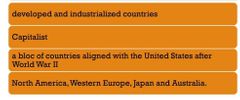![]()
![]()
![]()
Use LEFT and RIGHT arrow keys to navigate between flashcards;
Use UP and DOWN arrow keys to flip the card;
H to show hint;
A reads text to speech;
31 Cards in this Set
- Front
- Back

|
global divides |
|
|
period of conflict and tension that began after WWII but was not an actual war |
cold war |
|
|
us vs union |
cold war 1945-1990 |
|
|
battle of ideologies |
cold war |
|
|
capitalism |
USA |
|
|
communism |
ussr |
|

|
first world |
|

|
second world |
|

|
third world |
|
|
They came up to a new and simpler classification, which is the |
north-south divide |
|
|
was drawn on the map as the dividing line between the global north (MEDCs or More Economically Developed Countries) and the global south (LEDCs or Less Economically Developed Countries). |
brandt line |
|
|
North-South divide can be seen in: |
Economy, Poverty, Development, Life expectancy, Literacy |
|
|
It comprises more developed countries located in the Northern hemisphere. |
global north |
|
|
Home to all the members of the G8 and to four of the five permanent members of UN Security Council. |
global north |
|
|
USA, Canada, and Western Europe |
global north |
|
|
95% has enough food and shelter and functioning education system as well |
global North |
|
|
Developed parts of Asia, Australia, and New Zealand |
global north |
|
|
It comprises less developed countries located in the tropical regions and the Southern hemisphere. |
global south |
|
|
Africa, latin America, and Asia |
global south |
|
|
It serves as a source for raw material for the North |
global south |
|
|
5% has enough food and shelter |
global south |
|
|
Developing Asia including Middle East |
global south |
|
|
developing nations |
southern hemisphere |
|
|
rich, industrialized, wealthy nation |
northern hemisphere |
|
|
Wallerstein’s Modern World System Categorized countries as: |
core, periphery, semi-periphery |
|
|
Includes high-income nations. The manufacturing base of the planet where resources funnel in to become the technology and wealth enjoyed by people |
core |
|
|
Includes middle income countries. Closer ties to the global economic core |
semi-periphery |
|
|
Includes low-income countries. Natural resources and labor support the wealthier countries, first as colonies and now by working for multinational corporations under neocolonialism |
Periphery |
|
|
Remains economically dependent on the core. Poor nations have few resources to export to rich countries. Rich countries buy the raw materials cheaply then process and sell them |
periphery |
|
|
The North-South divide has more recently been named the development gap. This places greater emphasis on closing the evident gap between rich (more economically developed) countries and poor (less economically developed countries) countries. |
development gap |
|
|
The United Nations has developed a program dedicated to narrowing the divide through its Millennium Development Goals. This includes improving education and health care, promoting gender equality, and ensuring environmental sustainability. |
closing the gap |

